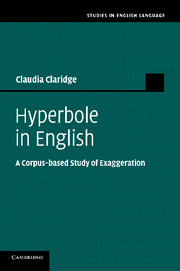Book contents
- Frontmatter
- Contents
- List of figures
- List of tables
- Acknowledgements
- 1 Introduction
- 2 The characteristics of hyperbole
- 3 Realisations of hyperbole
- 4 Using hyperbole: the speaker perspective
- 5 Hyperbole in interaction
- 6 Conventionalisation
- 7 The rhetoric of hyperbole
- Conclusion
- Appendix 1 Modern corpora used (Chapters 1, 2, 3, 4, 5 and 6)
- Appendix 2 Modern sources other than corpora (Chapters 2, 3, 4 and 5)
- Appendix 3 Conventionalisation in dictionaries (Chapter 6)
- Appendix 4 Corpora, dictionaries and texts used for the diachronic investigation (Chapter 6)
- Appendix 5 Sources used in Chapter 7
- References
- Index
7 - The rhetoric of hyperbole
Published online by Cambridge University Press: 04 February 2011
- Frontmatter
- Contents
- List of figures
- List of tables
- Acknowledgements
- 1 Introduction
- 2 The characteristics of hyperbole
- 3 Realisations of hyperbole
- 4 Using hyperbole: the speaker perspective
- 5 Hyperbole in interaction
- 6 Conventionalisation
- 7 The rhetoric of hyperbole
- Conclusion
- Appendix 1 Modern corpora used (Chapters 1, 2, 3, 4, 5 and 6)
- Appendix 2 Modern sources other than corpora (Chapters 2, 3, 4 and 5)
- Appendix 3 Conventionalisation in dictionaries (Chapter 6)
- Appendix 4 Corpora, dictionaries and texts used for the diachronic investigation (Chapter 6)
- Appendix 5 Sources used in Chapter 7
- References
- Index
Summary
The preceding chapters, in particular, Chapters 4 and 5, have dealt mostly with the everyday uses of hyperbole. But as occasional references to Quintilian in Chapters 2 and 3 have already indicated, hyperbole as a concept has its roots in the system of classical rhetoric. Hyperbole thus needs to be seen in the larger context of the art of persuasion. Figures of speech such as hyperbole are used in this context in a consciously strategic manner in order to reach fairly well-defined aims. Such highly deliberate uses are found in texts, types and contexts with various aims (and, of course, also in everyday speech). Furthermore, it is likely that hyperbole is distributed across registers and genres in a non-random manner, with some of these encouraging the use of hyperbole and others doing the opposite. A full-scale genre investigation is beyond the scope of this book, but it is possible to highlight some types with very different (functional) orientations and thus also, differential use of hyperbole. The analyses in this chapter will therefore further elucidate the functions of hyperbole beyond those singled out in Chapter 4. The present chapter will focus on registers and genres such as political discourse as a typical persuasive register, humorous texts as a primarily entertaining category, and literature as a type that combines persuasive, entertaining and instructive/edifying features.
- Type
- Chapter
- Information
- Hyperbole in EnglishA Corpus-based Study of Exaggeration, pp. 216 - 262Publisher: Cambridge University PressPrint publication year: 2010



